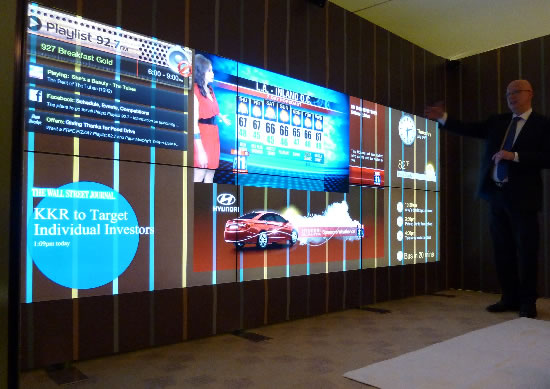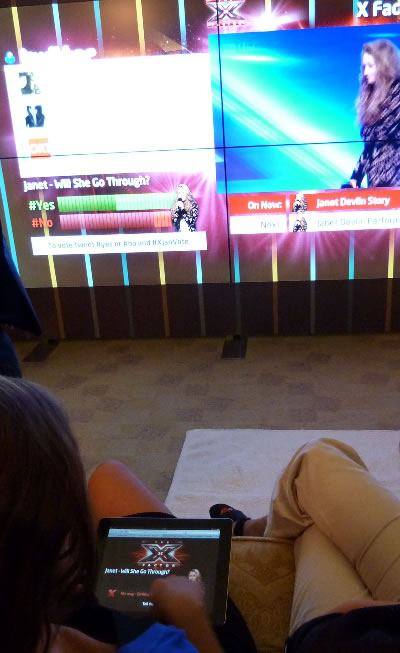At recent TV technology meetings in Washington, DC, NDS presented a demonstration of a new way of watching TV - its "Fresco" project.
(C)onsumers of tomorrow may have expansive video screens available, perhaps covering entire walls of their homes or workplaces. NDS and others feel that this future is not far away, given the progress in OLED development that could soon lead to large display arrays assembled from smaller elements. The OLED panels could be super-thin, frameless, and either transparent when off, or coupled with electrophoretic ink (“E-Ink”) panels – as used today in many e-book readers – to provide a static background pattern. “It could be like tiling your bathroom,” as NDS’s Simon Parnall described.The "Fresco" project envisions future displays as unobtrusive, ultra-High Definition (at least 4K), immersive, and ambient.
Parnall explained that such a display would “live with the viewer or family in the home,” displaying items that might today be presented by physical pictures on the wall, calendars, clocks, magnetic notes posted on the fridge, and the like. The display could also be used to present multiple simultaneous content elements (from broadcast, broadband or in-home sources), sized and arranged or the screen appropriately, or a single content element at a large size – so called “full immersion.”Parnall stressed the importance of including and utilizing metadata within video and data feeds, particularly in broadcast feeds. The metadata (information about the content/app) could adjust display parameters automatically, and assist users' devices to make better choices on available viewing (or storage) options. He also mentioned the opportunity for revenue generation from having such a large display canvas (putting ads, links, apps, etc. beside the primary broadcast feed, instead of overlaying them on top of the broadcast picture.
What's slowing implementation is that direct-view screen sizes are nearing screen sizes that aren't viable in most consumer viewing contexts (too big for available wall space, too large to get through doors or around corners in stairs or hallways, and too heavy. Today's largest plasma and LCD displays (and the demo in this case) use multiple smaller displays assembled together and linked to an external video driver that splits the video feeds among the component displays. OLED technology offers the potential of thin and flexible screens that will eventually be ramped up to the kind of sizes and area coverage that "Fresco" envisions - but for now quality and manufacturing concerns have left large-screen OLEDs too expensive for general consumer use.
Still, those attending the demo found it useful in terms of providing an idea about possible future viewing options, and the various opportunities for combining video and data in new, potentially profitable ways.
Source - NDS "Fresco" Demonstration Envisions a Bold Future of Television, TV TechCheck
For somewhat similar visions of the future of displays, check GE's A Day Made of Glass, A Day Made of Glass 2, and Day 2 - Unpacked (discusses specifics of technology and current viability) videos.


No comments:
Post a Comment